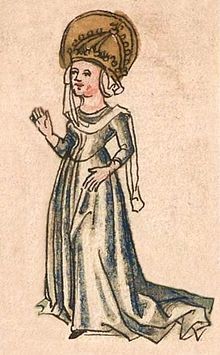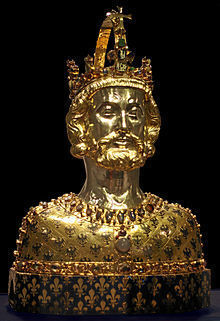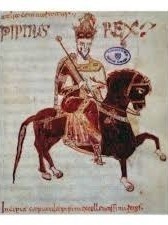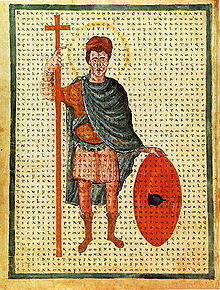Arbre généalogique Snelder - Versteegh » Queen Hildegarde of Vinzgau (758-783)
Données personnelles Queen Hildegarde of Vinzgau
Source 1- Elle est née en l'an 758.
 Attention: Avait moins de 16 ans (15) lors de la naissance (??-??-773) de l'enfant (Carloman (Pepin) Of Franks).
Attention: Avait moins de 16 ans (15) lors de la naissance (??-??-773) de l'enfant (Carloman (Pepin) Of Franks). - Elle est décédée le 30 avril 783, elle avait 25 ans.
- Un enfant de Gerold Von Vinzgau et Emma of Hnabi
Famille de Queen Hildegarde of Vinzgau
Elle est mariée avec Charlemange (Charles I) of the Franks.
Ils se sont mariés.
Enfant(s):
Notes par Queen Hildegarde of Vinzgau
https://en.wikipedia.org/wiki/Hildegard_of_the_Vinzgau
rgin: 0.5em 0px; color: #202122; font-family: sans-serif; font-size: 14px; background-color: #ffffff;">Hildegard (c. 754[2] – 30 April 783), was a Frankish queen consort who was the second[3] wife of Charlemagne and mother of Louis the Pious. Little is known about her life, because, like all women related to Charlemagne, she became notable only from a political background, recording her parentage, wedding, death, and her role as a mother.[4]]background-color: #ffffff;">She was the daughter of the Germanic Count Gerold of Kraichgau (founder of the Udalriching family) and his wife Emma, in turn daughter of Duke Nebe (Hnabi) of Alemannia and Hereswintha vom Bodensee (of Lake Constance).[5] Hildegard's father had extensive possessions in the dominion of Charlemagne's younger brother Carloman, so this union was of significant importance for Charlemagne, because he could strengthen its position in the east of the Rhine and also could bind the Alemannian nobility to his side.[6]t-size: 14px; background-color: #ffffff;">It is unknown if Charlemagne planned his marriage before the sudden death of Carloman or was just a part of the purposeful incorporation of his younger brother's Kingdom, in detriment of the claims of his nephews.[7] In any event, the wedding between Charlemagne and Hildegard took place at Aix-la-Chapelle certainly before 30 April 771, after the repudiation of the Lombardian princess Desiderata, Charlemagne's previous wife.nt-size: 14px; background-color: #ffffff;">It is generally accepted that she was either 12 or 13 upon her marriage to Charlemagne.[8][9], though her nominal date of birth would place her at 17. Girls could be married at any time after puberty, and in Roman law, which the Church upheld, the age of 12 was well established as being adequate.[10] ;An intense physical relationship between the spouses was demonstrated by the fact that, during her 12 years of marriage, Hildegard had 8 pregnancies (including one set of twins). Quite remarkably, the chronicles never mention either miscarriages or stillbirths, indicating that she was of sturdy health despite her young age at the time of the wedding.22; font-family: sans-serif; font-size: 14px; background-color: #ffffff;">Hildegard accompanied Charlemagne on many of his military campaigns. She gave birth to her second child and first daughter, Adelaide, during the siege of Pavia, capital of the Kingdom of the Lombards (September 773/June 774), but the child died during the return journey to France. In 778, Hildegard accompanied her husband as far as Aquitaine, where she gave birth to twin boys Louis and Lothair.[11] In 780/781, she traveled with Charlemagne and four of their children to Rome, where the sons Louis and Carloman (the latter renamed Pepin after his baptism by Pope Adrian I) were appointed sub-kings of Aquitaine and Italy respectively. This contributed to the strengthening of the alliance between the Carolingians and the Papacy.[12] Because of her frequent pregnancies, it can be presumed that Hildegard accompanied her husband on further campaigns, at least temporarily.line: none; color: #0645ad; background: none;" title="Paul the Deacon" href="https://en.wikipedia.org/wiki/Paul_the_Deacon">Paul the Deacon, from the after effects of her last childbirth.[13] She was buried the following day (1 May 783) in the Abbey of Saint-Arnould in Metz. Following the wishes of Charlemagne, near her grave were burning candles and daily prayers were said for her soul.[14]ffffff;">Hildegard made several donations to the monasteries of St. Denis and St. Martin of Tours.[15] She was a friend of Saint Leoba, who reportedly lived some time with her at court. She intervened in Hildegard's religious education and also offered her spiritual advice.[16] Together with her husband she commissioned the Godescalc Evangelistary,[17] where for the first time she was explicitly mentioned as Queen -also of the Lombards- through the joint signature of documents with her husband.[18]-color: #ffffff;">Hildegard enjoyed in her own lifetime from a high reputation, as was demonstrated in her obituary written by Paul the Deacon.[19] However, these compliments are to be regarded with some skepticism. In her Epitaph were included phrases that may have been introduced to flatter Charlemagne: for example, the reference to the fact that Hildegard was the epitome of beauty, wisdom and virtue. This were common words used by medieval writers to their rulers.[20] Pope Adrian I, in a letter to Charlemagne, expressed his condolences over the untimely death of Hildegard.x; background-color: #ffffff;">Hildegard used her position as Queen consort to obtain for her siblings several territorial and monetary benefits; as far was known, she was the only of Charlemagne's wives or concubines who managed to obtain for a relative an office after her marriage.[16] In addition, was also assumed that she, like other medieval queens, held several roles, such as ruling the court or being the representative (or regent) of the sovereign during his absence. This could mean that she was in close contact with all the government decision of her husband.[21] the Monastery of Kempten (founded in 752), who received financial and political support. From Italy they brought after the conquest of the Kingdom of the Lombards in 773/774 the relics of the Roman martyrs Saints Gordianus and Epimachus to Kempten, whom, along with the Virgin Mary, are the patrons of the monastery.n Kempten as one of the founders; her bust graced the pin crest and some coins of the later Imperial Abbey. In the late Middle Ages it was alleged that Hildegard was buried in Kempten, as well as her son Louis the Pious; there was built the so-called Hildegard Chapel (Hildegardkapelle), which quickly became a place of pilgrimage and where several miracles are reported. This explains why the Queen was revered as a saint in the Allgäu and always presented with an aureola. In the 17th century the building of another Hildegard Chapel at the Fürstäbtliche of Kempten was projected, but this was abandoned after the secularization. her importance in the urban development at Kempten is still very noticeable: The central square in front of St. Lorenz Basilica was named the Hildegard Square (Hildegardplatz) in her honor. In 1862 a Neo-Gothic Hildegard fountain (Hildegardsbrunnen) was erected in the square, which was closed in the 1950s. An idealized portrait painted by Franz Weiß was part of the facade of the local Landhaus. Also, in 1874 was founded the Hildegardis-Gymnasium Kempten Lyceum, originally exclusively for girls. At the Lindau Road, close to the school, was also located another Hildegard Fountain. On the facades of some houses were shown the image of the Queen, and on the edge of the Kempten forest there was the Hildegard Oak (Hildegardseiche) for several years until it was replaced by a new plantation. Until the 1950s, many girls born in Kempten were named after Hildegard.ext-decoration-line: none; color: #0645ad; background: none;" title="Pepin the Hunchback" href="https://en.wikipedia.org/wiki/Pepin_the_Hunchback">Pepin the Hunchback) from his first union with Himiltrude, he was not considered an heir after the rebellion in which he participated in 792. In his will of 806 (the called Divisio Regnorum), he divided his domains between the three surviving sons of Hildegard. Because her son Louis the Pious succeeded Charlemagne as Emperor, Hildegard is often called "mother of Kings and Emperors".15'); margin: 0.3em 0px 0px 1.6em; padding: 0px; color: #202122; font-family: sans-serif; font-size: 14px; background-color: #ffffff;">e: none; color: #0645ad; background: none;" title="Charles the Younger" href="https://en.wikipedia.org/wiki/Charles_the_Younger">Charles (772/773 – 4 December 811 in Bavaria[22]), the eldest son according to Paul the Deacon, who recorded his parentage.[23] His father associated him in the government of Francia and Saxony in 790, and crowned joint King of the Franks at Rome on 25 December 800, but died before his father.[18]tom: 0.1em;">Adelaide (September 773/June 774 in Italy – July/August 774, buried Metz, Abbey of Saint-Arnould). Born during the siege of Pavia, she was named after an early deceased sister of Charlemagne.[24] She died during the return journey to France.[25] She is named daughter of King Charles by Paul the Deacon, when recording her place of burial,[23] who also wrote an epitaph to "Adeleidis filia Karoli regis" specifying that she was born in Italy.[26]org/wiki/Rotrude">Rotrude (775 – 6 June 810[27]), named after her paternal great-grandmother. "Hruodrudem et Bertham et Gislam" are named daughters of King Charles and Hildegard by Einhard.[28] Angilbert's poem Ad Pippinum Italiæ regum names (in order) "Chrodthrudis...Berta...Gisla et Theodrada" as daughters of King Charles.[29] She was betrothed in 781 with Constantine VI, Emperor of Byzantium, and received the name Erythro in preparation for her future wedding. The betrothal was broken in 787,[30] and she, like all her sisters, remained unmarried. From a liaison with Rorgo of Rennes she had one son, the latter Louis, Abbot of Saint-Denis.epin_of_Italy">Carloman (777 – 8 July 810 in Milan, buried Verona, San Zeno Maggiore), renamed Pepin in Rome on 15 April 781 by Pope Adrian I, and crowned King of Italy that day. He also predeceased his father. (Chasseneuil-du-Poitou, Vienne, 16 April/September 778 – 20 June 840 in Ingelheim, buried Metz, Abbey of Saint-Arnould). He is named, and his parentage recorded, by Paul the Deacon, which specifies that he was his parents' third son, born a twin with Lothair.[23] Crowned King of Aquitaine in Rome on 15 April 781 by Pope Adrian I, his father named him as his successor at Aix-la-Chapelle, crowning him as joint Holy Roman Emperor on 11 September 813.ash; 779/80). He is named, and his parentage recorded, by Paul the Deacon, which specifies that he was his parents' fourth son "qui biennis occubuit", born a twin with Louis,[23] and also wrote an epitaph to "Chlodarii pueri regis" naming "Karolus...rex genitorque tuus, genitrix regina...Hildigarda" and specifying that he was a twin.[31]tyle="text-decoration-line: none; color: #0645ad; background: none;" title="Bertha, daughter of Charlemagne" href="https://en.wikipedia.org/wiki/Bertha,_daughter_of_Charlemagne">Bertha (779/80 – after 11 March 824), named after her paternal grandmother. An offer by Offa of Mercia to arrange a marriage between her and his son, Ecgfrith, led to Charlemagne breaking off diplomatic relations with Britain in 790, and banning British ships from his ports.[32] Like her sisters, she never married, but from her liaison with Angilbert, a court official, she had two sons: Hartnid (about whom little is known) and the historian Nithard, Abbott of St. Riquier.-bottom: 0.1em;">Gisela (before May 781 – after 800, maybe after 814). Named after her surviving paternal aunt, she was baptized in Milan in May 781.[33](an unusual practice at that time), she is named daughter of King Charles by Paul the Deacon, when recording her place of burial,[23] and also wrote an epitaph to "Hildegardis filiæ [Karoli regis]" specifying that she lived 40 days and her mother died after giving birth to her.[34]
Barre chronologique Queen Hildegarde of Vinzgau
Cette fonctionnalité n'est disponible que pour les navigateurs qui supportent Javascript.
Cliquez sur le nom pour plus d'information.
Symboles utilisés:  grand-parents
grand-parents
 parents
parents
 frères/soeurs
frères/soeurs
 enfants
enfants
 grand-parents
grand-parents
 parents
parents
 frères/soeurs
frères/soeurs
 enfants
enfants
Les sources
- WikiTree, via https://www.myheritage.nl/research/colle...
Hildegarde Of the Franks (geboren Of Swabia)Geslacht: VrouwGeboorte: 758Overlijden: 30 apr 783Echtgenoot: Charlemagne Of the FranksKind: Pepin Carloman Of Franks
www.wikitree.com
Des liens dans d'autres publications
On rencontre cette personne aussi dans la publication:Sur le nom de famille Of Vinzgau
- Afficher les informations que Genealogie Online a concernant le patronyme Of Vinzgau.
- Afficher des informations sur Of Vinzgau sur le site Archives Ouvertes.
- Trouvez dans le registre Wie (onder)zoekt wie? qui recherche le nom de famille Of Vinzgau.
La publication Arbre généalogique Snelder - Versteegh a été préparée par Roel Snelder.
Lors de la copie des données de cet arbre généalogique, veuillez inclure une référence à l'origine:
Roel Snelder, "Arbre généalogique Snelder - Versteegh", base de données, Généalogie Online (https://www.genealogieonline.nl/stamboom-snelder-versteegh/I502435.php : consultée 27 avril 2024), "Queen Hildegarde of Vinzgau (758-783)".
Roel Snelder, "Arbre généalogique Snelder - Versteegh", base de données, Généalogie Online (https://www.genealogieonline.nl/stamboom-snelder-versteegh/I502435.php : consultée 27 avril 2024), "Queen Hildegarde of Vinzgau (758-783)".




